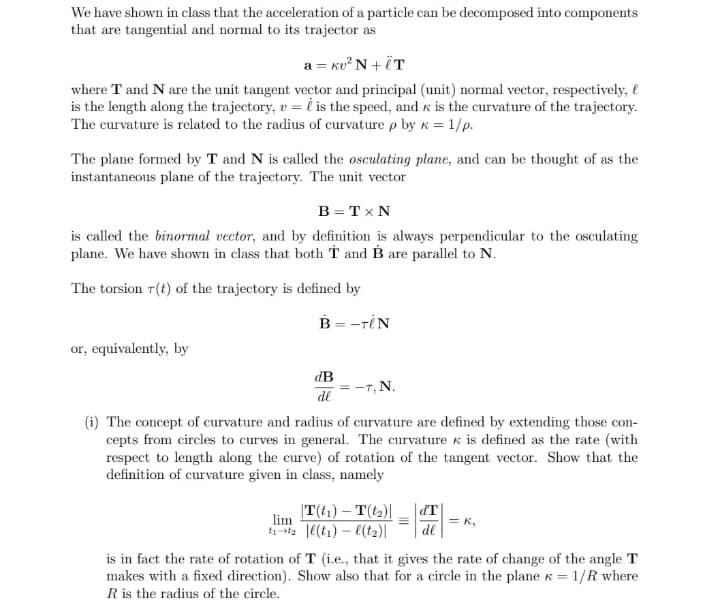de lim 1₁-1₂ = -T, N. (i) The concept of curvature and radius of curvature are defined by extending those con- cepts from circles to curves in general. The curvature & is defined as the rate (with respect to length along the curve) of rotation of the tangent vector. Show that the definition of curvature given in class, namely T(t₁) - T(t₂)| (t₁) -l(t₂)| d'T de is in fact the rate of rotation of T (i.e., that it gives the rate of change of the angle T makes with a fixed direction). Show also that for a circle in the plane = 1/R where R is the radius of the circle.
de lim 1₁-1₂ = -T, N. (i) The concept of curvature and radius of curvature are defined by extending those con- cepts from circles to curves in general. The curvature & is defined as the rate (with respect to length along the curve) of rotation of the tangent vector. Show that the definition of curvature given in class, namely T(t₁) - T(t₂)| (t₁) -l(t₂)| d'T de is in fact the rate of rotation of T (i.e., that it gives the rate of change of the angle T makes with a fixed direction). Show also that for a circle in the plane = 1/R where R is the radius of the circle.
Algebra & Trigonometry with Analytic Geometry
13th Edition
ISBN:9781133382119
Author:Swokowski
Publisher:Swokowski
Chapter11: Topics From Analytic Geometry
Section11.4: Plane Curves And Parametric Equations
Problem 33E
Related questions
Question

Transcribed Image Text:We have shown in class that the acceleration of a particle can be decomposed into components
that are tangential and normal to its trajector as
a = kv²N+ÏT
where T and N are the unit tangent vector and principal (unit) normal vector, respectively,
is the length along the trajectory, v = is the speed, and is the curvature of the trajectory.
The curvature is related to the radius of curvature p by k = 1/p.
The plane formed by T and N is called the osculating plane, and can be thought of as the
instantaneous plane of the trajectory. The unit vector
B = TX N
is called the binormal vector, and by definition is always perpendicular to the osculating
plane. We have shown in class that both T and B are parallel to N.
The torsion r(t) of the trajectory is defined by
B = -TIN
or, equivalently, by
dB
de
= -T, N.
(i) The concept of curvature and radius of curvature are defined by extending those con-
cepts from circles to curves in general. The curvature & is defined as the rate (with
respect to length along the curve) of rotation of the tangent vector. Show that the
definition of curvature given in class, namely
|T(t₁) - T(t₂)|
lim
t₁-t₂|l(t₁) -l(t₂)|
d'T
de
= K₂
is in fact the rate of rotation of T (i.e., that it gives the rate of change of the angle T
makes with a fixed direction). Show also that for a circle in the plane x = 1/R where
R is the radius of the circle.
Expert Solution
This question has been solved!
Explore an expertly crafted, step-by-step solution for a thorough understanding of key concepts.
Step by step
Solved in 3 steps with 3 images

Recommended textbooks for you

Algebra & Trigonometry with Analytic Geometry
Algebra
ISBN:
9781133382119
Author:
Swokowski
Publisher:
Cengage

Algebra & Trigonometry with Analytic Geometry
Algebra
ISBN:
9781133382119
Author:
Swokowski
Publisher:
Cengage